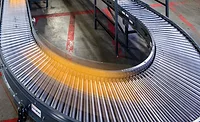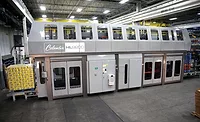Operations
Conveyors focal point of beverage operations
Diversity of packaging impacts conveyors

Image courtesy of Ryson International Inc.
From simple to specialty conveyors with deep inclines to space-saving vertical conveyors, in the wake of SKU proliferation, smaller batches and more frequent changeovers, beverage conveyors not only have to handle a plethora of packaging shapes and sizes, but original equipment manufacturers (OEMs) need to ensure that their conveyors — and all of their automation technology — are outfitted for the present and the future.
Terry Wicklum, senior consultant for Precision Distribution Consulting (PDC), York, Pa., explains that automation has been called the “future” of warehousing for many years. “Automation technology, including conveyors, has matured now to the point that I’m comfortable saying it is ‘the present and the future,’” he says. “That being said, there is no solution that I have seen that should be considered as a one-size-fits-all, or that is appropriate for all applications.
“Every operation is different and should be evaluated independently when making purchase decisions,” Wicklum continues. “Operators should make well informed decisions based not only on how their business looks now, but how they expect it to look in the future. Factors like space, capacity, SKU growth, labor and maintenance are just some of the factors to consider when evaluating technology. Operators should be aware that their workforce may be likely to decrease, and many jobs can be simplified; there will also be some new skills and proficiencies needed at the same time.”

Brandon Brownlee, account representative for Birmingham, Ala.-based Motion, concurs that automation is the driving force behind the many improvements in packaging today, along with reliability-centered maintenance and the leaps and bounds of the Industrial Internet of Things (IIoT).
“The ability to monitor the entire process plus asset condition monitoring allows you to improve productivity and reduce downtime. The ability to design new flexible conveyors is never-ending. Conveying in a straight and level line is the past — now, the sky is the limit,” he says. “Depending on the product you are producing, there are many styles of conveyors, from table-top and mat-top conveyors to traditional belting. Add in gravity roller, powered live roller and several styles of accumulation, and your choices are endless. Designing a conveyor system is like conducting a symphony orchestra — you must call on the right section to produce the sound you want. You need to know how to use all your resources and all automation to get the system you want and need.”
With the increase in online ordering now and in the future, more OEMs will be pressed for on-demand processing, which will likely include infinitely more diverse packaging and fulfilment requirements, notes Ken Rygh, marketing manager at Ryson International Inc.
“Flexibility and the ability to quickly react to shifts in demand will help set manufacturers apart,” he says.
As sustainability impacts the lightweighting of plastic water bottles and aluminum cans, conveying systems must adapt for smoother handling of more fragile packaging that easily can be dented or damaged, Rygh adds.
The Yorktown, Va.-based company offers spiral convers for vertical product transportation in two categories: case handling spirals for beverage products that are packaged or overwrapped, and mass flow spirals that handle cans or bottles in mass or single file.
“Case spirals have carrying surface widths from six inches to 36 inches and can operate at up to 200 feet per minute,” Rygh says. “Mass flow spirals come in widths from six inches to 20 inches and feature larger spirals able to handle 2,000 products per minute depending on the container diameter.”
Chain conveyor optimizes beverage operations
Founded in 1933 by Italian immigrant Antonio Origlio, the Philadelphia-based Origlio Beverage has steadily grown to operating three warehouses and delivering more than 18 million cases annually of domestic, import, craft and beyond beer brands such as Coors, Miller, Angry Orchard, Truly and White Claw — all told, more than 150 brands — throughout eastern Pennsylvania.
When it came time to making capital improvement upgrades, the family-run business selected the MA-DX LoPro Drag Chain Conveyor system from Orion, a division of ProMach.
“It was an easy choice to go with this machine — it was an easy sell,” says Phil Origlio, vice president of corporate development for Origlio Beverage, in a statement. “I told my family I was confident that in just a couple of months, we’ll cut our errors in half, and we’ve more than done that. If anything, I undersold it.”
Origlio notes that efficiently moving millions of cases from its shelves to customers was becoming a challenge because its picking process did not have a meaningful quality assurance program in place. Pallets were not being weighed for accuracy prior to shipping and the distributor was relying on its drivers to manage the whole check-in process and hand count as many as 1,700 cases of beer.
However, that tedious and unreliable process gave way to the adoption of Orion’s MA-DX LoPro Drag Chain Conveyor system, which was designed specifically for the beverage industry and now serves as a focal point of operations.
The MA-DX LoPro Drag Chain Conveyor system is a safe and efficient method to wrap and move tall pallets of beer and other beverages. The low profile, three-strand chain conveyor system automatically receives, wraps and discharges loads with designated specifications. Because it has a pass height of only four inches, it can accept three pallets at one time, allowing it to be operated by just one person, which saves on labor costs, the company says.
The basic system includes one infeed conveyor, one wrap zone conveyor and one exit conveyor. The machine automatically applies pre-stretched film to the loads, cut the film, wipe the film tail to the load, and contain the film for application to the next load. Loads automatically are sequenced through the conveyors and controlled by photocells and the PLC.
“The MA-DX LoPro Drag Chain gives Origlio Beverage the ability to reduce their material handling time by being able to drop off two pallets at the same time,” says Travis Range, Orion’s regional sales manager who worked on the project with Origlio. “We were able to rework their operations processes to a single point of access, which reduces the number of touch points for each pallet.”
No cookie-cutter conveyor systems
Experts note that modularity, flexibility, higher speeds and the ability to handle a wide variety of products without adjustments are among the benefits of today’s conveyors. They also suggest that plant managers should invest in more than their current requirements dictate and ensure that spare parts are readily available.
“In many cases, conveying systems are not cookie-cutter, and they require review plus collaboration with engineering and maintenance to accommodate the application’s requirements on the line or lines,” Motion’s Brownlee says. “Systems can be copied across a company, but there is not a single solution — hundreds of suggestions can be made to maximize efficiency and output. I would look at a conveyor that is cutting-edge and proven, that can easily adapt to your varying packaging needs. In addition, I would make sure that the components, if possible, are commercially available. Too many times, I have seen a customer invest in capital for new equipment only to be required to make another huge MRO investment in spare parts due to noncommercial availability or special to one manufacturer.”
Technical design advancements for conveyor systems have included smaller radius spirals designed to handle smaller and lighter packages, Ryson International’s Rygh says. He notes that higher speeds with more reliable conveying have been streamlined and there’s more flexibility to handle various product lines and sizes with the same conveying machinery without having to shut down for change parts or adjustments, he adds.
As conveyors have evolved, OEMs have designed these solutions to take up less space. “Traditionally vertical conveying was done with a simple incline conveyor, but that has a substantial footprint,” Rygh explains. “Gripper conveyors are also common, but they have a lot of moving parts, and need to be adjusted perfectly to handle each SKU. A spiral conveyor both has a very compact footprint, and does not require adjustments for various sized SKUs.”
Automated conveyor systems also are reducing touchpoints and spiral conveyors are improving operations by going vertical.
“In the case of spirals specifically, opening up floor space by taking product overhead and allowing multi-level operations without using a lot of floor space to elevate the product [are benefits],” he adds.
Motion’s Brownlee concludes: “The beverage market will not change with evolution but with revolutionary change. The marketplace for beverages and packaging continues to be in flux, plus sustainable packaging will continue to challenge packing requirements. Conveyor manufacturers will need to focus on being flexible and having products that can be modified in-plant for numerous sizes and shapes.”
Looking for a reprint of this article?
From high-res PDFs to custom plaques, order your copy today!





